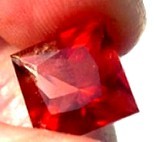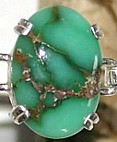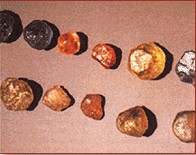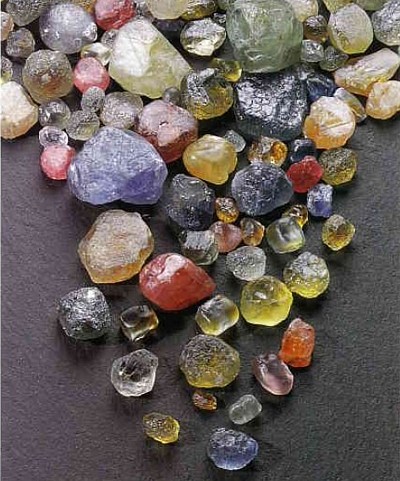
Dig Your Own Sapphire Gems In Montana

 |
Dig Your Own Sapphire Gems In Montana
|
 |
Montana is a well known for a number of interesting "dig your own" sapphire locations. The directions here will tell you all you need to know to hunt there......
|
The first gem-quality sapphires in the United States were discovered in the gravels of the Missouri River in Lewis and Clark County, Montana in 1865. The discovery is attributed to Ed Collins, a gold miner who was working on one of the gravel benches, or "bars," just above the Missouri River near Helena. This find was followed by a number of other discoveries in the late 1800s, including Rock Creek in Granite County in 1892, and in Yogo Gulch in Judith Basin County in 1895. Facilities where the visitor can find his own sapphires are available in two areas, along the Missouri River and also at Rock Creek. The adventure of finding your own sapphires is a fascinating and fun filled experience suitable for the entire family, including the kids. While most of the sapphires produced from both Rock Creek and the Missouri River are of a pale color that is not particularly desirable for jewelry, gemologists have found that with special treatment to a red hot heat, the color of these gems is permanently altered to a much more desirable shade. With the advent of successful heat-treating techniques for the Montana sapphires, this gem material has gained a much greater acceptance in the gemstone industry. This enhanced acceptance has resulted in a significant increase in the market for and value of U.S. sapphires. Unfortunately, not all Montana sapphires are suitable for heat- treating because of variations in chemical composition within the crystal. Also, the sapphires from the Missouri River respond to heat-treating differently than those from Rock Creek The response to heat-treating can vary also depending upon the method (individual) used to treat the sapphires. Nearly all the sapphires in the world go through a heat treating process which improves the clarity of the stone and often intensifies the color. This change is within the entire stone, not just on the outer surface of the stone, as are some other enhancement processes used for other gemstones. For much more information about sapphire gems, be sure to check out my Sapphire information web page. |
||
|
It has been found that a smaller percentage of the Missouri River sapphires respond positively to heat treatment as compared to those mined at Rock Creek. It is reported that 20% to 30% of Missouri River sapphires show a significant color improvement as a result of heat treatment. The corresponding treatment improvement rate for the equivalent Rock Creek material is in the range of 65%. Heat-treating produces desirable blue colors but also improves the color of fancy colored sapphires. Bright yellows and oranges can also be produced by heat-treating. Additionally, heat-treating improves the color of some pinks by removing colors that can interfere with the desirable pink shades. Heat treating and faceting services for your best gem stones are available to the public through the mines. To learn more about facet cutting gemstones, be sure to see my Facet cutting information page |
 Heat Treated Sapphire Rough, Missouri River Area |
|
|
Digging your own Montana sapphires on the
Missouri River: Currently there are up to seven
operations on the Missouri River that produce sapphires commercially and/or
operate a dig-for-fee area. Not all of these may be active in any one year,
so it is best to check around.
Perhaps the best-known Sapphire mine on the Missouri River which is open to
the public is the Spokane bar mine. Digging your own sapphires is not free,
but the costs are very reasonable. The Spokane gravel bar was named by
geologists mapping the Missouri River area in the early 1900's. The name may
have referred to the Spokane Hills which composed of Spokane shale. This
gravel bar is the location of an exciting sapphire strike along the Missouri
River. |
||
| Piles of boulders were mined the visitor of the areas
historic gold mining past. Four major gravel terraces containing both
sapphire and gold deposits are present at Spokane Bar. The terraces are
visible on both sides of the river about 150 to 200 feet above the river's
current level. The old gold mining area is now overgrown with pine trees,
juniper and brush, and this historic site has become a haven for both
wildlife and present-day miners. Today's visitors can still see the remnants
of ditches that hint of a complex water system that carried water from a
source ten miles away. This 'hydraulic' mining system flushed dirt and
gravel away from the hill into wooden sluice boxes.
Visitors will find sapphires in every color at the Spokane Bar Sapphire
Mine. The natural Sapphire crystal structure is hexagon with triangle
terminations which are often flat. The most commonly found color at the mine
is a green-blue shade. While blue sapphire is the best known color, usually
heat treatment is required to produce this type of color in the Missouri
River sapphires. Ruby is sapphire which is colored red, and it is one of the
most prized gems of all. |
 Heat Treated Sapphire Rough, Rock Creek Area |
|
|
Digging for Montana sapphires at Rock Creek The Rock Creek sapphires are generally similar to the sapphires from the Missouri River but differ in the typical shape of the crystals. The stones are basically crude hexagonal plates about the same dimension in width and height, with a much higher percentage of the material being well rounded water worn pebbles. There appears to be more of the larger sized (greater than a half inch) material at rock Creek. Additionally, the natural colors of the Rock Creek material is just a bit better than the material from the Missouri River, and as a result a greater percentage of stones which are mined here can be heat-treated for a significant color improvement. During the past several years, there has been only a single producer on Rock Creek. The gem mountain property has operated both a commercial recovery plant and a fee recovery area. The fee recovery area sold buckets of gravel for washing and also offered, for a predetermined fixed fee, the output of one day's operation of the commercial wash plant. The presence of sapphire deposits at Rock Creek, Montana, has been known since the late 1890s. In fact, from 1906 to 1943 they were mined almost continuously to provide corundum for industrial applications. While most sapphires from this deposit are of gem clarity the hues in which they typically occur in rather uninteresting natural colors of pale blue pale green, faint pink, pale yellow, or near colorless. These colors are not commercially desirable. Although natural blue, yellow, and pink sapphires with good color saturation are found at Rock Creek, the quantities of natural material are just too small to justify commercial mining for these gems alone. Luckily, a large percentage of the pale, poorly colored gems can be improved by heat treatment. Rock Creek is unique in that it was the only placer deposit in Montana rich enough to be mined for its sapphire alone. During the years from discovery to World War II, the main mining area was mined almost continuously. Enormous quantities of sapphire have been mined from Rock Creek over the years. Many tons of sapphire material was deemed sufficiently clean and fracture free to be used for precision industrial applications. Production of man made sapphire for watch bearings and other uses put an end to those operations. Sapphire has been found over a wide are and in many tributary creeks in the Rock Creek area. |
||
|
Since 1943, there has been little interest in commercially mining the Rock Creek deposits. A portion of the deposit, currently known as the Gem Mountain Sapphire Mine, has been operated for many years as a fee digging area for hobbyists and individual gem miners. It is now operated as a fascinating tourist attraction where individuals can screen sapphires from sapphire-bearing ore mined by the operators.
At Gem Mountain, gravel dug by the
mine owners is purchased and sorted for its sapphires. Every bucket is
guaranteed to contain at least some sapphires. It is not necessary for the visitor to bring any equipment to the
mine, as the facility provides everything a visitor needs to find their own
Montana sapphires. Company staff teach how it is done, and do all the heavy
lifting, so all the visitor has to do is show up and sift through the gravel
to find the sapphires hidden in each bucket. From May 19th through October
9th, the Gem Mountain sapphire mine is open to the public seven days a week,
from 9:00 am until 5:00 p.m. (from Memorial Day to Labor Day, evening hours
are extended until 7 pm). |
Heat Treated and cut Montana Sapphires |
|
|
Above: Gem Mountain Sapphire Mine Near Phillipsburg in Granite County, Montana |
DIRECTIONS TO GEM MOUNTAIN MINE:
The Gem Mountain sapphire mine is situated between Butte and Anaconda and Hamilton on Route 38, which is the same as Skalkaho Road. Six miles south of Philipsburg turn from Highway 1 and drive 16 miles west. Look for the signs, and turn and cross the small bridge over the West Fork of Rock Creek – that’s the parking lot for the mine. |
|
 Above: Spokane Bar Sapphire Mine Near Helena in Lewis and Clark Co., Montana |
DIRECTIONS TO SPOKANE BAR MINE: Spokane Bar
Sapphire Mine and Gold Fever Rock Shop is located northeast of Helena,
Montana. Take York Road to Mile Marker 8, turn right on Hart Lane, after
road makes 90 degree turn left on Castles Road. The mine is open to tourists
all summer from April to October, with daily operating hours between
9:00am - 5:00pm.
For more rock hound adventures, Click here to return to: The Rock Hounds Corner |
|
|
|
||
Want to know a little bit more about this crazy prospector guy? Well, here's a little bit more about me, and how I got into prospecting: Chris' Prospecting Story Interested in seeing natural gold? Here are some interesting photos of beautiful Gold Nuggets